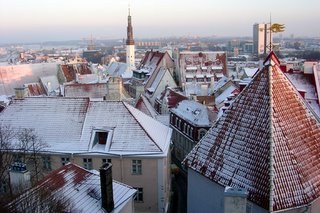 Inari and I took a two-day trip from Helsinki to Tallinn, Estonia. Tallinn is about 3 hours away by ferry, and a crazy ferry ride it is. Estonia has become something of a weekend getaway for Finns for a variety of reasons: it’s cheaper, it’s familiar but foreign, and because you can buy duty-free alcohol on the ferries. This latter point is very important because alcohol is highly taxed in Finland.
Inari and I took a two-day trip from Helsinki to Tallinn, Estonia. Tallinn is about 3 hours away by ferry, and a crazy ferry ride it is. Estonia has become something of a weekend getaway for Finns for a variety of reasons: it’s cheaper, it’s familiar but foreign, and because you can buy duty-free alcohol on the ferries. This latter point is very important because alcohol is highly taxed in Finland.Estonia has traditionally been something of a sister country to Finland. The languages and cultures are very similar, and there has been a lot of trading between the countries throughout the years. This was put to halt for about 60 when Estonia was occupied by the Soviet Union, but has resumed in recent years. The relationship has changed though, and the wounds of the communist days have not healed completely. I think the relationship can be compared to a situation in which one sibling is locked up and abused for years, and the other is unable to help (how could Finland free Estonia from the Soviet Union?) and of course feels very bad about the situation. Estonia suffered some very difficult times that it is still unable to openly discuss, so you can imagine that there is some awkwardness between Estonia and Finland. This is not helped by the fact that many Finns traveling to Estonia assume that Estonians living in Tallinn can speak Finnish, which is often true, for they were able to watch Finnish television during the Soviet days, but is probably not the best way to rejuvenate an old relationship. At the moment, Estonians probably feel closer to Latvians and Lithuanians since they had common histories during a very difficult time period.

Tallinn is one of the oldest cities in northern Europe, first mentioned in text in the 1100’s. A wall was built around the city in the early 1300’s or so; much of the wall and old buildings are still standing. Tallinn has been conquered and re-conquered many times, but somehow survived every battle. The Soviets were content to let Tallinn fall to ruins, leaving many of the buildings in a state of disrepair. But Tallinn persevered, and is now having a re-birth that started with the end of communism. I found it to be a very interesting conglomeration of history: some very old buildings that have stood for centuries, some very modern buildings that have been built in the past 15 years, and everywhere scars of communism.


